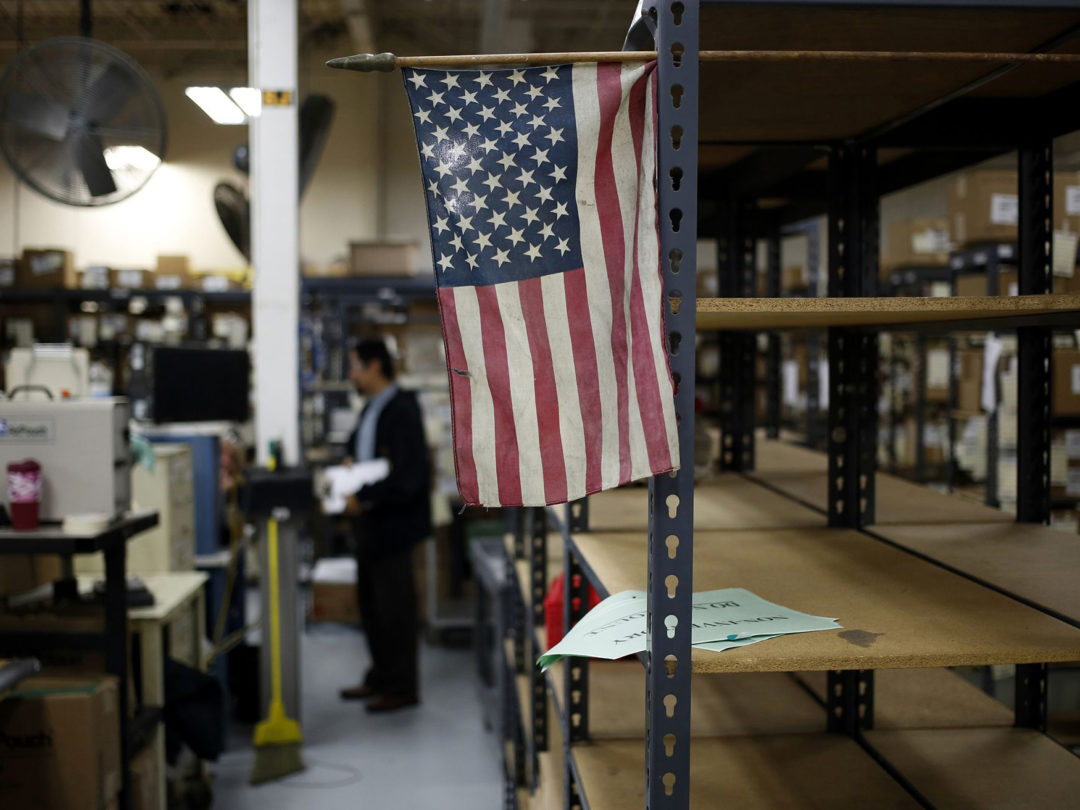
Think Tank
Pandemic Reshoring: Five Things to Consider Before Making a Move

A U.S. flag is displayed on a factory floor in Bowling Green, Kentucky. Photo: Bloomberg.
An appetite for reshoring and onshoring may be growing due to the coronavirus pandemic, with more than two-thirds of North American manufacturers looking to bring production back home, according to a recent survey by Thomasnet.com.
For most, a host of complex factors will determine if, when and where to relocate — including proximity to existing operations, access to logistics networks, ease of technology implementation and more. In some cases, North America might be no more fitting than China.
Vietnam, Ukraine and Indonesia rank the highest among 40 countries in Savills’ Nearshoring Index, which measures manufacturing labor costs, electricity costs, infrastructure and trade openness. The United States and Canada rank 35th and 28th, respectively, but higher access to automation in these countries may help offset other costs.
Before making a move, here are five key areas companies should consider.
1. Labor. The availability of a skilled workforce is often the top criterion in factory site selection. Companies will decide where to locate their facilities by the type of workforce available within commutable distance to the site selected, and whether it can fill their operational needs.
In response, state governments such as Michigan, California, and Florida implemented career and technical education (CTE) programs and vocational education for their residents to both attract companies and revitalize their communities. Some local governments even tailored the training programs for the company they want to attract to their areas. Companies with a robust workforce strategy can identify what talent can be nurtured locally to decide where to restore.
Previously, companies offshored to countries like China for its low-cost workforce that is generally low skilled and high transaction. But as China developed, its cost competitiveness has eroded. Unit wage costs (the average cost of wages per unit of output) for manufacturing have risen by 285% over the past 20 years. On the flipside, domestic production cost has been going down as robotics and artificial intelligence have replaced labor workers. Advanced technology has replaced many of the monotonous and repetitive tasks with automation while limiting labor use to functions that cannot be automated.
There is some resistance in large-scale automation due to the large upfront capital expenditure. Additionally, there are political sensitivities in some markets because low-income jobs are often the most vulnerable to automation. Nonetheless, we are seeing a shift recently, particularly as technology becomes cheaper, labor is used to focus on completing more sophisticated tasks throughout the supply chain. A study conducted by the International Federation of Robotics (IFR) found that manufacturers have benefitted from the use of robots. In fact, they are better able to compete in global supply chains as well. Moreover, the cost of implementing automation can be categorized as capital investment, which federal, state, and local governments are likely to incent with additional tax breaks. Technology is also deemed a hedge against future labor market disruption. The use of artificial intelligence will be most widespread across companies in assembling, picking, packing, and fulfillment, which increases productivity, lowers the risk of worker injuries, and enables the facility operations to meet omni-channel demands.
2. Tax incentives. Most states also offer a myriad of incentive programs to lure new corporate and manufacturing facilities into their communities. The property tax abatements and economic development incentives may offset the costs of moving, real estate investment, equipment purchase, and even positively impact the company’s financial reporting.
For instance, the state of Maryland offers tax credits for 10 years incentivizing technology and advanced manufacturing companies to set up facilities in one of 149 distressed communities to create jobs in old steel mill and mining towns.
Prior to the 2017 Tax Cuts and Jobs Act (TCJA), U.S. tax policy penalized companies for bringing earnings back into America generated in other countries, i.e., they were double taxed on these funds. The tax structure has evolved making reshoring a more attractive move. The tax was restructured whereby the top corporate income tax rate was reduced from 35 percent to 21 percent, bringing the U.S. rate below the average for most other Organization for Economic Co-operation and Development countries.
While many of these incentives predated COVID pandemic, federal agencies and many state and local governments have already responded to the COVID-19 crisis with additional programs designed to ensure that businesses survive. With the heightened need to increase employment opportunities, these programs will likely continue. Many tax breaks are negotiable with state and local economic development teams, but tax credits for creating jobs are set by law. Rebates and incentives are offered based on the number of new jobs a new operation will create. Companies should investigate and take a multi-analyses approach to determine where to reshore. It is crucial that companies review their incentive commitments for their projects, consider capital and headcount pledges, determine incentives at risk, and strategize ways to combat claw back exposures, if any.
3. Freight and operational efficiency. Some companies that have reshored have indicated that their revenue-cost and risk analyses have proven it to be more efficient to manufacture within North America than in China. This is partly because wages for manufacturing jobs in China have tripled since 2005. They also found the longstanding quality and productivity issues from China production persist today. Asian factories often use unapproved suppliers or components, creating finished products that differed from samples. The lack of quality control, intellectual property theft, and the less-than-desirable responsiveness compounded the offshoring headache.
With manufacturing and assembly plants located within North America, companies can implement a more robust just-in-time inventory management system and therefore benefit from proximity to the fulfillment and logistics hub to fulfill increasing e-commerce sales. Stretching the supply chain across the ocean has proven unfeasible during COVID-19, as companies still need to maintain inventory, not just of the finished goods but also of the raw materials needed in the completion of some products. COVID-19 would make reshoring even more desirable as it would remove such breakpoints along the supply chain.
4. Energy infrastructure and management. As with incentives, there are many energy and waste management initiatives run at both federal and state levels that offer ease of operation for all types of manufacturers. This is vastly different from many parts of Asia, where these resources aren’t as enforced. The well-constructed and connected rail, road, and air network in North America make reshoring a better option as companies basically relocate to their customers while having access to reasonably priced, trustworthy energy and utility sources that some of the developing countries lack.
The wind energy initiative is one of the many energy source initiatives launched to attract manufacturing to the U.S. The areas marked in green on the map are locations of land-based and offshore wind turbines (source: U.S. Wind Turbine Database-USWTDB). There is an exponential growth in wind energy supported by the Department of Energy (DOE) and Wind Energy Technologies (WETO), with operations in every state to build the capabilities and make it available and affordable to the both public and private sectors.
5. Real estate availability and accessibility. The industrial real estate market is weathering the pandemic crisis but finding the right space in prime location remains a challenge. The short supply is exacerbated with big box companies like Amazon gobbling up much of the area within the last mile delivery zone of many metropolitan cities.
While many of the brownfield and old industrial sites in the last mile area are already redeveloped, there are still real estate spaces available in the middle mile areas close to the logistics route that should be considered. This includes areas along the Mason Dixon line, north of the Gulf of Mexico, Southwest Arizona, and the New Mexico region. The lower cost of labor, favorable incentives offered, and proximity to population density area make these regions great options for manufacturing sites.
Adam Petrillo is senior managing director and head of industrial services, and Ann Marie Collins is executive vice president of workforce and incentives strategy, at Savills.






